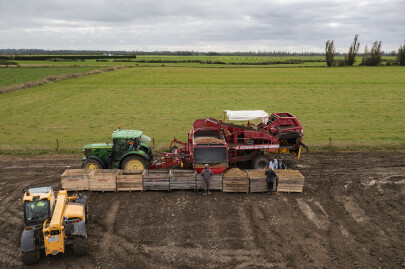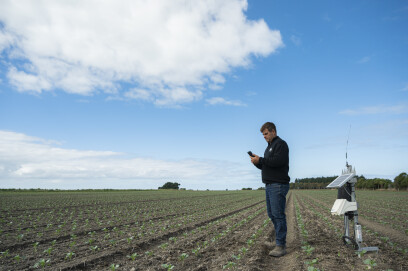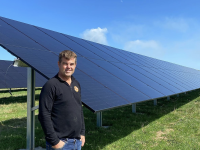
AgMatters Environmental Case Study
The following was originally published on the AgMatters New Zealand website.
Fifth-generation farmer, Robin Oakley, has been growing vegetables in Canterbury since he was a kid and now supplies supermarkets around the country. His family is committed to sustainable farming and is starting to think about what that means for the climate.
About the farm
Robin and Shirleen Oakley own Oakley’s Premium Fresh Vegetables. They grow potatoes, broccoli, beetroot, and pumpkin across 450ha of owned or leased land in Southbridge on the Canterbury plains.

Potato harvesting at Oakley’s (Photo: Dave Allen Photography)
The Oakley family has been growing crops in the area for over 150 years – the flat topography, Waimakariri silt loam soils and temperate climate make for great growing conditions. Their vegetables are now available year-round (other than pumpkin, which is seasonally available from April-November) at most major supermarkets in the South Island and in parts of the North Island.
Environmental focus
“Growing food comes with responsibilities,” says Robin. “People should be able to ask us how our vegetables are grown, what impact there is on the environment and what we’re doing to reduce it. And we should be able to provide an honest answer.”
Over the years, Robin has developed a detailed understanding of his soil and the crops it supports. Crop rotation is key in Robin’s approach – helping improve soil structure and fertility and minimising build-up of pathogens and pests. A comprehensive precision agriculture programme is also followed.

Robin checking soil data (Photo: Dave Allen Photography)
The soil is tested before, during and after crops have gone through and moisture probes help accurately monitor water levels so they can better predict what is needed. The paddocks are e-mapped to determine where there are variances that might affect crop nutrition. Regular plant testing also takes place and fertiliser applications are split throughout the plant life cycle to minimise leaching and increase yield. Cover cropping between rotations helps soak up excess nitrogen and they have significantly changed their cultivation practices, aiming to support good soil structure and health.
Everything is recorded in a database, providing valuable information to help them achieve reliable outcomes from their crops while also protecting their soils.
These efforts have seen the Oakleys recognised with several farm environment and innovation awards.
The Oakleys are also connecting and contributing in other ways. In April 2022 they installed a 220kw solar operation to power their packhouse at Southbridge – one of the largest installations in the South Island. They sponsor charities and sports teams in their community and regularly supply vegetables to their local food bank.
The Oakleys greenhouse gas numbers
In the next few years, New Zealand farmers and growers will have to know their agricultural greenhouse gas numbers and have a written plan for reducing them.
A number of tools are available for farmers and growers to find out their greenhouse gas numbers. Robin uses OverseerFM to get his – more information on this tool and others is available on our Knowing your numbers page.
| Oakleys | 2020/21 |
| Farm area (ha) | 310.2 |
| Total biological GHGs from the farm (tonnes CO2-e) | 147.2 |
| Average biological GHGs per hectare (tonnes CO2-e/ha) | 0.47 |
| Total methane per ha (tonnes CO2-e) | 0.06 |
| Total nitrous oxide per ha (tonnes CO2-e) | 1.41 |
| Total carbon dioxide per ha (tonnes CO2-e) | 0.04 |
| Total methane (kg)* | 775.5 |
| N leaching as kg N/ha | 9.8 |
*The weight of methane is shown here without conversion to CO2-e because this is how it would be required to be reported in any farm-level pricing mechanism.
As shown in the table above, the main agricultural greenhouse gas for Robin is nitrous oxide, driven by the amount of nitrogen fertiliser applied to his crops.
There is also a small amount of carbon dioxide associated with this fertiliser use and a very small amount of methane, emitted by a neighbour’s sheep brought in to graze between some crop rotations.
Robin has long believed that “you can’t manage what you haven’t measured”. Now that he has his greenhouse gas numbers together, he can turn his attention to identifying ways to minimise his impact on the climate.
On-farm actions
The Oakleys are already farming very efficiently and have been focused on reducing their nitrogen leaching for a while now. The aim for them now is fine-tuning their operations – looking for further ways to reduce nitrogen fertiliser use. Here are the main things they are doing in that area:
- Developed expertise in the crops they grow, understanding where and when inputs are needed
- Sophisticated crop rotation system
- Variable rate irrigation to optimise crop growth and avoid nutrient runoff
- Investment in precision agriculture systems to ensure fertiliser is applied exactly where and when it is needed
- Cover cropping
- Soil testing to optimise and minimise inputs
You can read about these actions and others on our on-farm actions page.
The Oakleys are also adding solar panels to their operation to power the main packhouse and coolstore on site. This is helping reduce their carbon dioxide emissions (separate to their efforts to reduce their agricultural greenhouse gas emissions).
Robin acknowledges that it can feel overwhelming and daunting at the start. His advice to other farmers and growers is to ask for help from the experts, get them to analyse the data and put a report together that is tailored for the farm and will help support decision-making.
“At the end of the day, we’re all caretakers of the land,” says Robin. “We’re all trying to bring out the best in our farms – how we look after them is how they look after us and our families.”
[instagram-feed]





